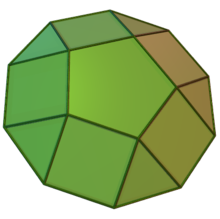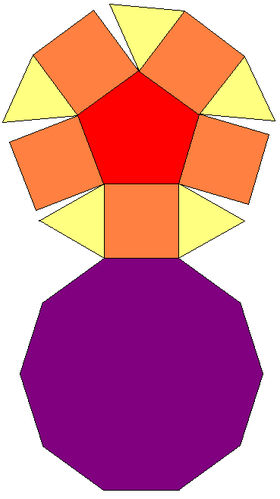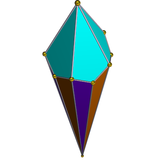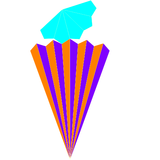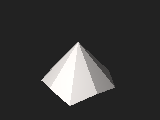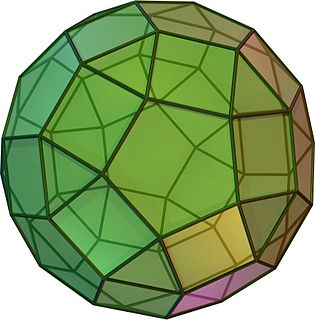
In geometry, the rhombicosidodecahedron is an Archimedean solid, one of thirteen convex isogonal nonprismatic solids constructed of two or more types of regular polygon faces.

In geometry, a pentagonal pyramid is a pyramid with a pentagonal base upon which are erected five triangular faces that meet at a point. Like any pyramid, it is self-dual.

In geometry, the triangular cupola is one of the Johnson solids. It can be seen as half a cuboctahedron.

In geometry, the square cupola, sometimes called lesser dome, is one of the Johnson solids. It can be obtained as a slice of the rhombicuboctahedron. As in all cupolae, the base polygon has twice as many edges and vertices as the top; in this case the base polygon is an octagon.
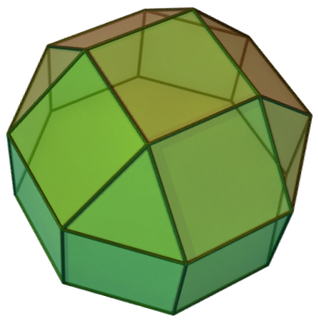
In geometry, the elongated square cupola is one of the Johnson solids (J19). As the name suggests, it can be constructed by elongating a square cupola (J4) by attaching an octagonal prism to its base. The solid can be seen as a rhombicuboctahedron with its "lid" removed.

In geometry, the elongated pentagonal rotunda is one of the Johnson solids (J21). As the name suggests, it can be constructed by elongating a pentagonal rotunda (J6) by attaching a decagonal prism to its base. It can also be seen as an elongated pentagonal orthobirotunda (J42) with one pentagonal rotunda removed.
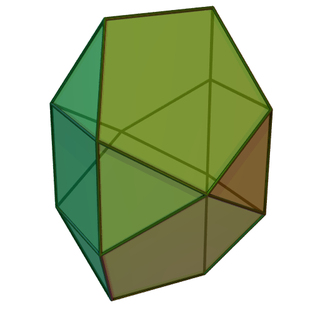
In geometry, the bilunabirotunda is one of the Johnson solids (J91). A Johnson solid is one of 92 strictly convex polyhedra that is composed of regular polygon faces but are not uniform polyhedra. They were named by Norman Johnson, who first listed these polyhedra in 1966.

In geometry, the triangular hebesphenorotunda is one of the Johnson solids (J92).

In geometry, the elongated pentagonal cupola is one of the Johnson solids (J20). As the name suggests, it can be constructed by elongating a pentagonal cupola (J5) by attaching a decagonal prism to its base. The solid can also be seen as an elongated pentagonal orthobicupola (J38) with its "lid" removed.

In geometry, the pentagonal orthobicupola is one of the Johnson solids (J30). As the name suggests, it can be constructed by joining two pentagonal cupolae (J5) along their decagonal bases, matching like faces. A 36-degree rotation of one cupola before the joining yields a pentagonal gyrobicupola (J31).

In geometry, the pentagonal gyrobicupola is one of the Johnson solids (J31). Like the pentagonal orthobicupola (J30), it can be obtained by joining two pentagonal cupolae (J5) along their bases. The difference is that in this solid, the two halves are rotated 36 degrees with respect to one another.

In geometry, the elongated pentagonal orthobicupola or cantellated pentagonal prism is one of the Johnson solids (J38). As the name suggests, it can be constructed by elongating a pentagonal orthobicupola (J30) by inserting a decagonal prism between its two congruent halves. Rotating one of the cupolae through 36 degrees before inserting the prism yields an elongated pentagonal gyrobicupola (J39).

In geometry, the elongated pentagonal gyrobicupola is one of the Johnson solids (J39). As the name suggests, it can be constructed by elongating a pentagonal gyrobicupola (J31) by inserting a decagonal prism between its congruent halves. Rotating one of the pentagonal cupolae (J5) through 36 degrees before inserting the prism yields an elongated pentagonal orthobicupola (J38).

In geometry, the elongated triangular cupola is one of the Johnson solids (J18). As the name suggests, it can be constructed by elongating a triangular cupola (J3) by attaching a hexagonal prism to its base.
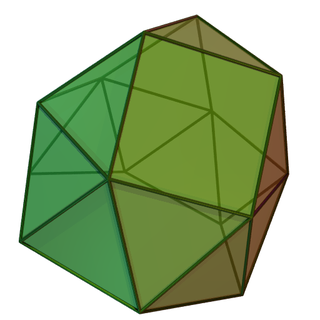
In geometry, the gyroelongated triangular cupola is one of the Johnson solids (J22). It can be constructed by attaching a hexagonal antiprism to the base of a triangular cupola (J3). This is called "gyroelongation", which means that an antiprism is joined to the base of a solid, or between the bases of more than one solid.

In geometry, the pentagonal orthocupolarotunda is one of the Johnson solids (J32). As the name suggests, it can be constructed by joining a pentagonal cupola (J5) and a pentagonal rotunda (J6) along their decagonal bases, matching the pentagonal faces. A 36-degree rotation of one of the halves before the joining yields a pentagonal gyrocupolarotunda (J33).
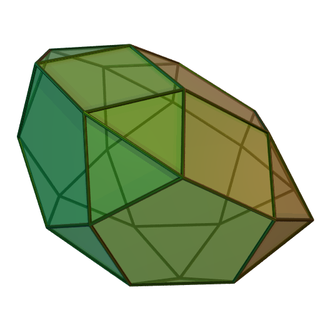
In geometry, the pentagonal gyrocupolarotunda is one of the Johnson solids (J33). Like the pentagonal orthocupolarotunda (J32), it can be constructed by joining a pentagonal cupola (J5) and a pentagonal rotunda (J6) along their decagonal bases. The difference is that in this solid, the two halves are rotated 36 degrees with respect to one another.

In geometry, the elongated pentagonal gyrocupolarotunda is one of the Johnson solids (J41). As the name suggests, it can be constructed by elongating a pentagonal gyrocupolarotunda (J33) by inserting a decagonal prism between its halves. Rotating either the pentagonal cupola (J5) or the pentagonal rotunda (J6) through 36 degrees before inserting the prism yields an elongated pentagonal orthocupolarotunda (J40).
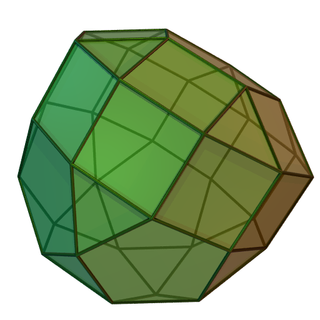
In geometry, the elongated pentagonal orthocupolarotunda is one of the Johnson solids (J40). As the name suggests, it can be constructed by elongating a pentagonal orthocupolarotunda (J32) by inserting a decagonal prism between its halves. Rotating either the cupola or the rotunda through 36 degrees before inserting the prism yields an elongated pentagonal gyrocupolarotunda (J41).
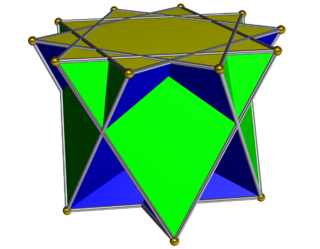
In geometry, the crossed pentagrammic cupola is one of the nonconvex Johnson solid isomorphs, being topologically identical to the convex pentagonal cupola. It can be obtained as a slice of the great rhombicosidodecahedron or quasirhombicosidodecahedron. As in all cupolae, the base polygon has twice as many edges and vertices as the top; in this case the base polygon is a decagram.
